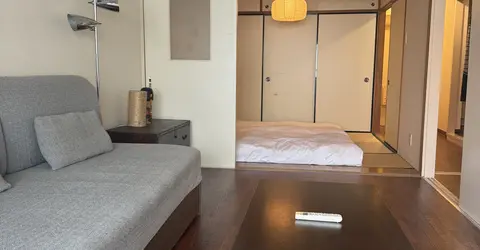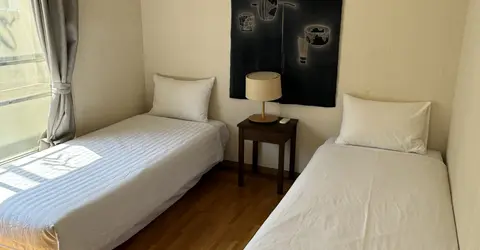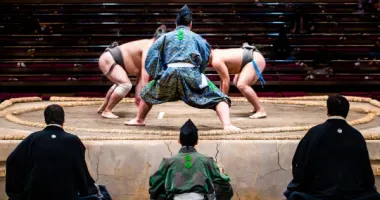Parliamentary Museum (Kensei Kinenkan)
The Parliamentary Museum (Kensei Kinenkan) near the National Diet Building in Tokyo is a free museum explaining the history of Japan's parliament and constitution.
Parliamentary Museum (Kensei Kinenkan) 憲政記念館
 The Kensei Kinenkan is dedicated to Japanese democracy and the life of Yukio Ozaki, known as the "God of constitutional politics" and the "father of the Japanese Constitution", Nagatacho, Tokyo
The Kensei Kinenkan is dedicated to Japanese democracy and the life of Yukio Ozaki, known as the "God of constitutional politics" and the "father of the Japanese Constitution", Nagatacho, Tokyo
The Parliamentary Museum (Kensei Kinenkan) in Nagatacho is a free museum close to the National Diet Building in central Tokyo.
History
The Parliamentary Museum was established in 1970 to celebrate the 80th anniversary of the Japanese parliament and fully opened in 1972. It serves to explain Japanese parliamentary democracy and its history to a wide range of people.
The site where the museum now stands is of considerable historical significance. At the beginning of the Edo Period, the warrior Kato Kiyomasa had a residence here. Later it became a mansion for the feudal lords of Hikone and was the home of Ii Naosuke (1815-1860), the chief minister of the last shogun and daimyo of Hikone.
It was Ii Naosuke who signed the Harris Treaty with the United States, opening various ports to foreign access and trade. For his pains he was assassinated at the Sakurada Gate of Edo Castle by hard-line samurai from Mito.
After the Meiji Restoration, the area was occupied by the General Staff Office and the Ministry of War.
 Replica chamber of the House of Representatives, Kensei Kinenkan, Nagatacho, Tokyo
Replica chamber of the House of Representatives, Kensei Kinenkan, Nagatacho, Tokyo
Statue of Ozaki Yukio (1859-1954), Kensei Kinenkan (Parliamentary Museum), Nagatacho, Tokyo
Exhibits
The Parliamentary Museum (Kensei Kinenkan) is on two floors. Just to your right at the entrance is the Ozaki Memorial Hall, which was built in 1960 and incorporated in to the museum when it opened in the 1970's.
Ozaki Yukio (1859-1954) has become known as the "God of constitutional politics" and the "father of the Japanese Constitution." He was elected for 25 terms (for Mie Prefecture) in the Japanese Diet (a world record) and held office for over 60 years. Ozaki was opposed to militarism, supported women's suffrage and was an internationalist. After the death of his first wife, he married the half-Japanese, half-British folklore author Yei Theodora Ozaki, with whom he spoke in English.
Ozaki was sometimes imprisoned for his views and also survived an assassination attempt by hiding in his garden.
In his position as Mayor of Tokyo he presented 3,000 cherry trees to the USA that formed the beginnings of the National Cherry Blossom Festival in Washington DC.
On display are some of Ozaki's personal effects, his writings, photographs and other memorabilia. They have explanations in Japanese and (some) English.
 Ozaki Memorial Hall, Kensei Kinenkan, Nagatacho, Tokyo
Ozaki Memorial Hall, Kensei Kinenkan, Nagatacho, Tokyo Exhibit cabinets, Kensei Kinenkan, Nagatacho, Tokyo
Exhibit cabinets, Kensei Kinenkan, Nagatacho, Tokyo
Also on the ground floor is a replica chamber of the House of Representatives with audio-visual displays of actual events that have taken place there. There are also video presentations on other parliaments around the world.
The second floor has a small movie theater showing a film that explains the history of the Japanese parliament from its beginnings in the ideas of the last days of the Tokugawa shogunate to the present day. The film details Japan's first Imperial constitution, the struggle for suffrage and the new post-war constitution.
These themes are also explained through an extensive collection of original photographs, newspapers, documents and wall panels.
 Print of the Seikanron (The Debate to Invade Korea in 1873), Kensei Kinenkan, Nagatacho, Tokyo
Print of the Seikanron (The Debate to Invade Korea in 1873), Kensei Kinenkan, Nagatacho, Tokyo
Parliamentary Museum (Kensei Kinenkan) Tokyo Hours
Open 10 am-5 pm daily including Sundays and national holidays. The museum is closed on the last day of the month, and the New Year period (12/28-1/4).
Admission
Free admission.
Access
Parliamentary Museum (Kensei Kinenkan) (www.shugiin.go.jp)
1-1-1 Nagata-cho, Chiyoda-ku, Tokyo 100-0014
Tel: 03 3581 1651
The Parliamentary Museum (Kensei Kinenkan) is a 7-minute walk from Kokkaigijidomae Station (Exit 2), on the Marunouchi and Chiyoda lines of the Tokyo subway.
Alternatively the museum is 5 minutes from Nagatacho Station (Exit 2) on the Yurakucho, Nanboku and Hanzomon lines.
Toei buses from Shinbashi Station to Otakibashi Shako go to the Kokkaigijidomae stop.
 Exhibit cabinets, Kensei Kinenkan, Nagatacho, Tokyo
Exhibit cabinets, Kensei Kinenkan, Nagatacho, Tokyo
Exhibit showing a poster for the new voting age of 18 in Japan, Kensei Kinenkan, Nagatacho, Tokyo





























